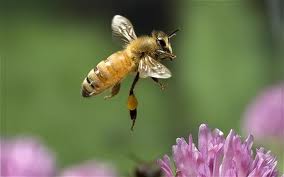Search
Democracy Links
Member's Off-site Blogs
beware the frankenfooders .....

With news that the U.S. honeybee population has been so devastated that some beekeepers will qualify for disaster relief dollars, comes a report from Purdue University that one of the causes of honeybee deaths is - as long suspected - neonicotinoids.
I say one of the causes, because the article does. In fact, the levels of neonicotinoid contamination of the powder used to spread seeds - up to 700,000 times the lethal dose - suggest that this pesticide may be the major, or precipitating, cause, with Varroa mites and other problems simply the straw that breaks the camel’s back.
And this, a myriad of causes, none of them dominant, is what agencies like the U.S.
Environmental Protection Agency (EPA), the U.S. Food and Drug Administration (FDA) and the U.S. Department of Agriculture would have us believe, either because (as some suggest) they are understaffed to adequately investigate Colony Collapse Disorder (CCD), or because some of their former (or present) members are in bed with major chemical and genetically modified (GM) seed manufacturers.
The study, by Christian Krupke (professor of entomology) and Greg Hunt (professor of genetics and honeybee specialist), explains that the contaminated powder is residue from the seed treatment. What happens is, corn and soybean seeds are treated with neonicotinoids in a talc base to keep them moving through today’s high-tech vacuum seed spreaders when it comes time to plant.
But not all the talc stays attached to the seeds. Some is released as residue due to excessive application or machinery vibrations, or when cleaning the seeders after use, and settles on nearby flowering plants or in the soil. Some even manages to survive the growing year intact on corn pollen.
One of the neonicotinoids, clothianidin (and its precursor, thiamethoxam), was also found regularly, albeit at low levels, in U.S. soils up to 24 months after treated seed was planted. This is the same insecticide, or pesticide already banned across much of Europe, including France, Italy, Germany, the UK and Slovenia.
Several countries, like Germany, have also sued clothianidin maker Bayer CropScience for its role in the manufacture and distribution of the highly toxic pesticide, which is aimed at replacing imidacloprid (whose patent ran out, so it doesn’t bring as much sales revenue to chemical corporations like Bayer CropScience!).
This is the same Bayer that came under the gun in 2010 for its GM rice, which contaminated three fields of genetically pure rice in Germany. The cost, to Bayer, was $1.5 million, but the truth is that the Big Five Frankenfood creators (Bayer, Monsanto, Syngenta, Dow and DuPont) rarely get tagged for their perversion of the natural world, making their takeover of the global seed market and their promotion of monocropping spectacularly successful (and almost complete, thanks to help from Codex Alimentarius).
Should you doubt this is true, consider the case of Monsanto in India, where the International Monetary Fund, or IMF, and the World Bank, both pushed regulators, who in turn pushed farmers to buy and sow expensive Monsanto cotton seed, which (because it carries a “terminator” gene) needs to be bought again every year, where once farmers either bought cheap, native cotton seed or saved seed for replanting.
When cotton fields from this GM seed failed to materialize - largely because farmers had been growing native cotton that required less water to survive - farmers lost everything. Many committed suicide by drinking the very (and also expensive) pesticides and weed killers tailor-made to work alongside their GM fields. The final death toll was 125,000.
Surprisingly, Europe - which seems to be dominated by a policy of central control (in everything from finances to law to farming), at least when compared to the U.S. - has been the staunchest opponent of Frankenfoods, from crop chemical to seed.
Not so the U.S., where beekeepers are losing about one-third of hives each and every year. But now the state of California, ever at the forefront of earth-friendly policies, has put forward a right-to-know referendum which will enable residents to find out about genetically engineered foods (i.e., who makes them, what they are, where they are sold) - something the U.S. Food and Drug Administration, or FDA, has stubbornly refused to demand in food labeling.
Nor has the U.S. Environmental Protection Agency (EPA) stepped up to the plate. In fact, it failed to pay attention to reports from its own scientists, and was completely taken in by the deeply flawed Bayer study about clothianidin-treated canola crops.
The situation in the U.S. has now reached what beekeepers and their advocates, like Steve Ellis of the National Honey Bee Advisory Board, are calling a ‘critical tipping point’ beyond which honeybee colonies may not survive to replenish themselves.
Thanks, Bayer et al; we needed that!
- By John Richardson at 29 Jan 2012 - 2:10pm
- John Richardson's blog
- Login or register to post comments
Recent comments
8 min 50 sec ago
34 min 25 sec ago
1 hour 14 min ago
3 hours 15 min ago
11 hours 18 min ago
22 hours 32 min ago
1 day 1 hour ago
1 day 1 hour ago
1 day 1 hour ago
1 day 11 hours ago